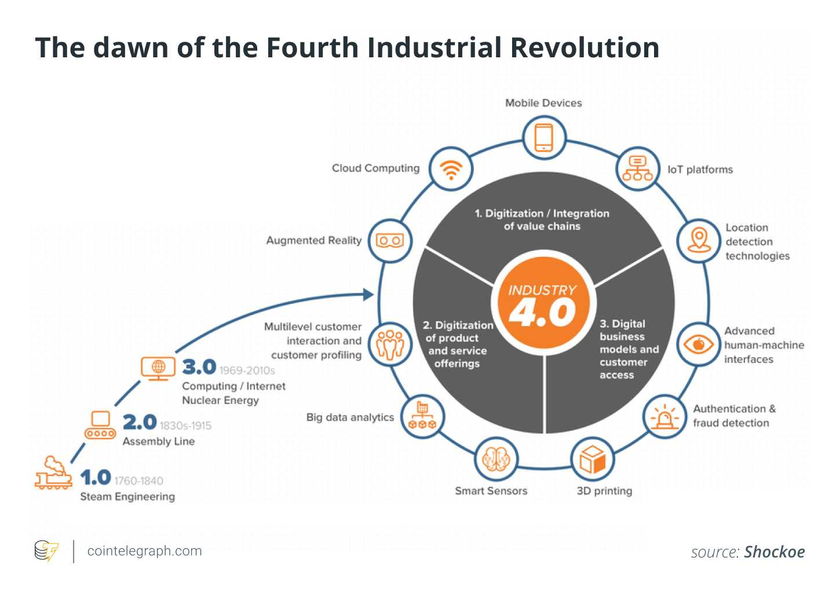Rethinking approaches to regulation of the Fourth Industrial Revolution
Turning away from voluntary, fragmented utilization of innovations and decentralized technologies will result in changing approaches to their regulation.
Mass adoption of technologies of the Fourth Industrial Revolution (4IR) potentially could trigger an even larger than projected transition to a new taxonomy of regulation concerning various fields of human life, including that of finance and the market itself. New technologies are enabling new concepts, systems and frameworks, such as driverless cars, drone postal deliveries and central bank digital currencies (CBDC). In the foreseeable future, the role of technology in our society would be exceeding the boundaries of an elementary subsystem, where its regulation would be designated to the stakeholders or the market itself.
A persistent theme of this short submission is the currently changing approaches to the regulation of technological risks following a rapid transition to the wholesale level leveraging and mass adoption of technologies. I tend to believe that effective regulatory design for new technologies embraced by the currently ongoing Fourth Industrial Revolution should, first of all, be considerate of prerequisites as set by the notions of dominant product design, public perception of technological risk and social benefits versus technological risks.
Turning away from a voluntary and fragmented utilization of technologies and more toward their mass adoption on a wholesale level, public perception toward the technologies’ risks, role and impact on society is continuing to evolve, subsequently resulting in changing approaches to regulation. This is better illustrated by an example of systems with organized complexity such as financial markets where technologies and computerization were of concern predominantly for the market itself. In comparison to the past industrial revolutions, which have not had a direct impact on the banking and financial sector, the currently unfolding 4IR has a direct influence and impact on the whole sector of global finance, which, as of today, is already one of the most digitized sectors of the global economy.
Financial markets were originally modeled as linear systems. Nowadays, however, they are increasingly global without a single point of control, unpredictable by means of nonlinear feedback effects arising from inter-activities among market participants and tend toward self-organized behavior. Comprising organized complexity or hierarchy in financial markets can be better described as arising out of investor demand. It could also subsequently exist in a highly interconnected system of subsystems present on the factor market — a market for financial assets — where delayed regulatory initiatives, first of all, can be attributed to the properties of its parts that initially look simple and the laws of their interpretation as not allowing to infer the properties of the whole. As Herbert Simon famously noted, justifying frequency with which complexity takes the form of hierarchy:
“In most systems in nature, it is somewhat arbitrary as to where we leave off the partitioning, and what subsystems we take as elementary.”
He continued: “Physics makes much use of the concept of ‘elementary particle’ although particles have a disconcerting tendency not to remain elementary very long. Only a couple of generations ago, the atoms themselves were elementary particles; today, to the nuclear physicist they are complex systems…[J]ust why a scientist has a right to treat as elementary a subsystem that is in fact exceedingly complex is one of the questions.”
In the foreseeable future, the role of technology in human lives would be exceeding the boundaries of an elementary subsystem, where its regulation would be designated to the sector as postal services for drones, financial regulations for robo-advisers companies or a particular market itself.
In its application, blockchains and other cross-cutting enabling technologies, commonly dubbed as the ABCD framework: artificial intelligence, blockchain, cloud and data (Big Data), as well as machine learning and Biometrics commonly embraced by the 4IR would not be mandatory limited to enabling new business opportunities fostering transparency and cost- and time-effective organization of the complex systems. It is fair to predict that future simplification and transformation of regulatory practices is likewise within its reach.
The innovation lifecycle
The innovation lifecycle for technologies of the 4IR has now progressed from fluid toward a more transitional phase. The rate of product innovation in an industry or product class is highest during its formative years, the so-called the fluid phase, where within the rich mixture of experimentation and competition, some center of gravity eventually forms in the shape of a dominant product design.
A dominant design as the landmark event for an industry (as hypothesized) has the effect of enforcing or encouraging standardization so that production or other complementary economies can be sought and perfected. At the same time, it may not meet the needs of a particular class to quite the same extent as would a customized design, nor is it a dominant design necessarily the one that embodies the most extreme technical performance. For example, the IBM PC, like the Model 5, offered the market little in the way of breakthrough technology, but it brought together familiar elements that had proven their value to users: a TV monitor, standard disk drive, QWERTY keyboard, the Intel 8088 chip, open architecture and MS-DOS operating system.
As the ABCD framework of enabling technologies used by fintechs, techfins and regtechs is currently approaching the dominant design stage, their product design model is principally dictated by regulation, a pattern which is similar to most of the regulated industries, including the sector of finance.
New significance and rationale behind the regulation of technologies have now emerged, embracing the acceleration of new forms of doing business on the market, a trend which is more and more commonly observed in many countries. It seems that the notion of Global Technology Risks (GTRs), which previously has not been an issue en vogue, will be gaining more and more pace, mandating changes to be made to regulatory approaches implemented worldwide. The reason for this is simple: The general public, which generally tends to underestimate the risks stemming from voluntary activities, as the utilization of technology has progressed from being purely voluntary such as transferring Bitcoin (BTC) using blockchain more toward the wholesale level of tech utilization (e.g. CBDC), is becoming more concerned of the upcoming risks requiring appropriate regulatory and supervisory response by regulators.
What seems important to emphasize is that the extent to which these responses should be based on technological advances such as embedded supervision ultimately depends on whether the industry itself will readily accept these advances for regulation or not.
https://cointelegraph.com/news/rethinking-approaches-to-regulation-of-the-fourth-industrial-revolution































